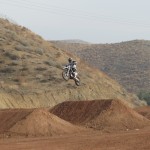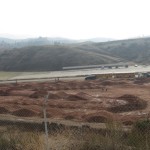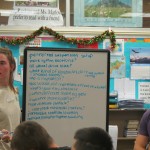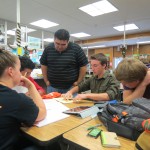MOTOCROSS: Poly’s new motocross program allows a diverse coalition of students to design their own track.
By Emily Hughes, Staff Writer
The Poly Motocross Program, created by Principal Dr. Michael Roe and executives from major motorcycle companies, has shifted into drive. A few weeks ago, select Poly students met in the library to discuss plans for creating a motocross track, which Roe dubbed the “Dream Track.” Later that same week, the students visited three motocross tracks to take measurements and discuss track ideas with experts in the field. Soon after that, they put their heads together once more and drew up their very own motocross course.
Roe designed this program as a learning tool for students. He hoped that it would teach them not only math and physics, but also journalism, racing and engineering. The first major step of this program began when the participating students spent an afternoon designing and forming questions about building a track. Students came together from different levels of math and physics classes, as well as from the Poly Motocross Club, Poly’s video crew and Matthew Gage Middle School.
Roe started off the meeting with a speech about the importance of the project, stating, “If you can navigate this room and organize yourselves in such a way where everybody is involved, everybody is participating, you are going to be doing what most fortune-500 companies spend top-dollar to figure out how to do. And that’s how to get people to work together.”
The students feel that they are both applying their prior knowledge to this project and learning from it. Ethan Schehl (7) from Gage Middle School commented, “I actually understand what’s going on and what I have to do.” Rigoberto Gonzales (11) said, “I want to provide my own math input, and while I’m teaching others what to do, I’m learning myself.”
Poly’s video crew was also present at the initial meeting. Gavin Shaw, a member of the club, filmed the process during the day. “We will be collecting footage, getting interviews, putting it together into three separate three-minute videos, and then we will be giving those to Fox News, and they might air on television,” Shaw said.
At the end of the meeting, the students came up with a list of questions for the motocross riders. Students also chose leaders who would be spearheads in the project.
Later in the week, these students visited three motocross tracks to take measurements and gain information from professionals. Among the professionals was Nathan Ramsey, a motocross racer who won the 1999 West Coast Lites Championship and who has been working with Roe since the beginning of the project. “Ultimately, the idea is to create something that is nationwide. I think now’s the right time because there are so many industry people who are really excited about it,” Ramsey said.
The students studied three different tracks, assessing the “whoops” and “berms,” which are measured piles of dirt that riders have to jump over or turn on. Many of the students commented that they felt they were very productive. “I feel we started pretty strongly. We have organization; we have a lot of leaders willing to step up and help organize. It seems that everyone is doing pretty well, getting the things they need and understanding what we’re going to do,” leader Alexander Schmutzer (10) said. Cole Parker (11), a physics student, mentioned, “I have a better understanding of how a track works, and my conceptual idea of how to build a track has much improved in this past hour. I feel very confident in myself to build the ‘Dream Track.’ ”
Along with math and physics, computer programming and art played vital roles in the process of designing the “Dream Track.” The track designs have come together, but they are still far from finished, as is the motocross project. The students now have the task of building a three-dimensional model of the track. Poly students like Jarrett Guillow (12) are up for the challenge. “I think it’s going to be difficult bringing all the information together, but if anyone can do it, we can,” Guillow said.





